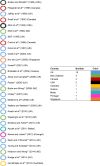Acute oxygen therapy: a review of prescribing and delivery practices
- PMID: 27307722
- PMCID: PMC4888716
- DOI: 10.2147/COPD.S103607
Acute oxygen therapy: a review of prescribing and delivery practices
Abstract
Oxygen is a commonly used drug in the clinical setting and like other drugs its use must be considered carefully. This is particularly true for those patients who are at risk of type II respiratory failure in whom the risk of hypercapnia is well established. In recent times, several international bodies have advocated for the prescription of oxygen therapy in an attempt to reduce this risk in vulnerable patient groups. Despite this guidance, published data have demonstrated that there has been poor uptake of these recommendations. Multiple interventions have been tested to improve concordance, and while some of these interventions show promise, the sustainability of these interventions are less convincing. In this review, we summarize data that have been published on the prevalence of oxygen prescription and the accurate and appropriate administration of this drug therapy. We also identify strategies that have shown promise in facilitating changes to oxygen prescription and delivery practice. There is a clear need to investigate the barriers, facilitators, and attitudes of clinicians in relation to the prescription of oxygen therapy in acute care. Interventions based on these findings then need to be designed and tested to facilitate the application of evidence-based guidelines to support sustained changes in practice, and ultimately improve patient care.
Keywords: COPD; chronic obstructive pulmonary disease; hypercapnia; hypoxia; oxygen therapy; prescribing; type II respiratory failure.
Figures


References
-
- Martin DS, Grocott MP., III Oxygen therapy in anaesthesia: the yin and yang of O2. Br J Anaesth. 2013;111(6):867–871. - PubMed
-
- Steinman Kaufman J, Kent B. Nursing management: obstructive pulmonary diseases. In: Brown P, Edwards H, Seaton L, et al., editors. Lewis’s Medical-Surgical Nursing Assessment and Management of Clinical Problems Australia and New Zealand Edition. 4th ed. Sydney: Mosby Elsevier; 2015. pp. 564–614.
-
- Kane B, Decalmer S, O’Driscoll BR. Emergency oxygen therapy: from guideline to implementation. Breathe. 2013;9(4):246–253.
-
- Blakeman TC. Evidence for oxygen use in the hospitalized patient: is more really the enemy of good? Respir Care. 2013;58(10):1679–1693. - PubMed
-
- Martin DS, Grocott MPW. Oxygen therapy and anaesthesia: too much of a good thing? Anaesthesia. 2015;70(5):518–522. - PubMed
Publication types
MeSH terms
LinkOut - more resources
Full Text Sources
Other Literature Sources
Medical

